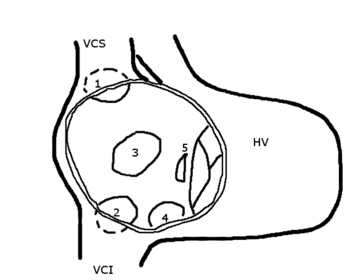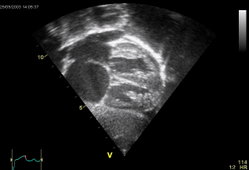Atrial septal defect
Atrial septal defects (ASD) are a group of congenital heart diseases that involve the interatrial septum of the heart. The inter-atrial septum is the tissue that separates the right and left atria from each other. Without this septum, or if there is a defect in this septum, it is possible for blood to travel from the left side of the heart to the right side of the heart, or the other way around, resulting in mixing of arterial and venous blood. more...
Since the right side of the heart contains venous blood with a low oxygen content, and the left side of the heart contains arterial blood with a high oxygen content, it is beneficial to prevent any communication between the two sides of the heart and prevent the blood from the two sides of the heart from mixing with each other.
During development of the fetus, the inter-atrial septum develops to eventually separate the left and right atria. The foramen ovale remains open during fetal development to allow blood from the venous system to bypass the lungs and go to the systemic circulation. This is because prior to birth, the oxygenation of the blood is via the placenta and not the lungs. A layer of tissue begins to cover the foramen ovale during fetal development, and will close it completely soon after birth. After birth, the pressure in the pulmonary circulation drops, and the foramen ovale closes. In approximately 30% of adults the foramen ovale does not seal over. In this case, elevation of pressure in the pulmonary circulation (ie: pulmonary hypertension due to various causes, or transiently during a cough) can cause opening of the foramen ovale. This is known as a patent foramen ovale (PFO).
Pathophysiology
In normal individuals, the chambers of the left side of the heart make up a higher pressure system than the chambers of the right side of the heart. This is because the left ventricle has to produce enough pressure to eject blood to the entire body, while the right ventricle has to produce enough pressure to eject blood to only the lungs.
In the event of an atrial septal defect, blood will flow from the left atrium to the right atrium. This is called a left-to-right shunt. This extra blood will cause a volume overload of both the right atrium and the right ventricle.
Any process that increases the pressure in the left ventricle can cause worsening of the left-to-right shunt. This includes hypertension, which increases the pressure that the left ventricle has to generate in order to open the aortic valve during ventricular systole, and coronary artery disease which increases the stiffness of the left ventricle, thereby increasing the filling pressure of the left ventricle during ventricular diastole.
The right ventricle will have to push out more blood than the left ventricle due to the left-to-right shunt. This constant overload of the right side of the heart will cause an overload of the entire pulmonary vasculature. Eventually the pulmonary vasculature will develop pulmonary hypertension to try to divert the extra blood volume away from the lungs.
The pulmonary hypertension will cause the right ventricle to face increased afterload in addition to the increased preload that the shunted blood from the left atrium to the right atrium caused. The right ventricle will be forced to generate higher pressures to try to overcome the pulmonary hypertension. This may lead to right ventricular failure (dilatation and decreased systolic function of the right ventricle) or elevations of the right sided pressures to levels greater than the left sided pressures.
Read more at Wikipedia.org



